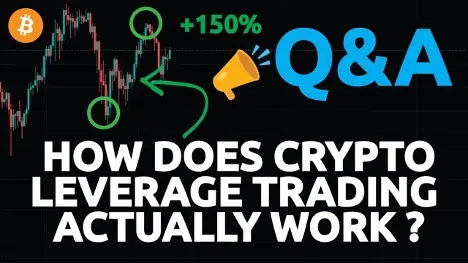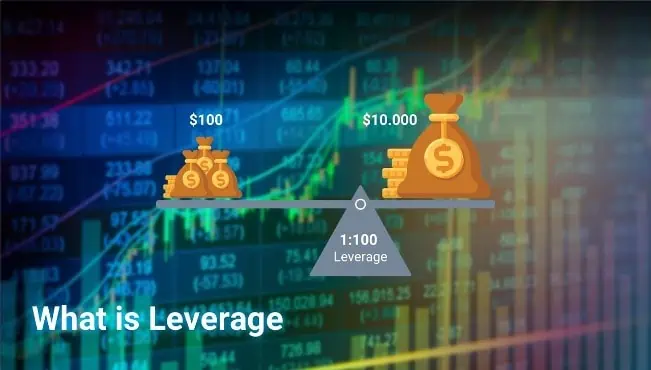If you’re looking to get involved in the world of cryptocurrency trading, leverage trading can be an exciting and potentially lucrative option. By borrowing funds from a trading platform, you can amplify your exposure to price movements in the cryptocurrency market.
However, as with any type of trading, leverage comes with risks as well as rewards. In this comprehensive guide, we’ll explore everything you need to know about leveraging trading in crypto, from the basics of how it works to advanced strategies and risk management techniques.
Introduction to Leverage Trading in Crypto
Cryptocurrencies have taken the world by storm, with Bitcoin being the most popular cryptocurrency. However, these digital assets are known for their volatility, which can be both a blessing and a curse for traders. While price fluctuations can provide opportunities for traders to make profits, they can also lead to significant losses. This is where leverage trading comes into the picture.
Leverage trading is a popular strategy used by traders to increase their gains or losses by borrowing funds from trading platforms and investing in a market with a much larger position size than their account balance. For instance, if a trader has $100 in their account and uses 10x leverage, they can trade with a position size of $1000.
However, it is important to note that leverage trading is a double-edged sword. While it can increase the potential for profits, it can also magnify losses. Therefore, it is crucial to understand the concept of leverage and how it works before getting involved in the world of leveraged crypto trading.
One of the benefits of leverage trading is that it allows traders to access more capital than they would have had otherwise. This means that traders with a small account balance can still participate in the market and potentially make significant profits. Additionally, leverage trading can be a useful tool for experienced traders who want to increase their exposure to the market.
However, leverage trading is not suitable for everyone. It requires a lot of discipline and risk management skills, as traders can lose more than their initial investment. Therefore, it is crucial to have a solid trading plan in place and to use stop-loss orders to limit potential losses.
In conclusion, leverage trading is a popular strategy used by traders to increase their gains or losses. While it can be a useful tool to access more capital and potentially make significant profits, it is important to understand the risks involved and to have a solid trading plan in place. With the right knowledge and skills, leverage trading can be a valuable addition to any trader’s arsenal.

How Leverage Trading Works
The idea behind leveraging is to borrow money or assets from a trading platform to increase a trader’s exposure to the market. Leverage trading has become increasingly popular among traders due to the potential for high returns. However, it is essential to understand the risks involved before diving in.
The borrowed money, also known as margin, serves as collateral for the trader’s position. The amount of leverage a trader uses depends on the margin requirements set by the platform and ranges from 2x to 100x or more. It is crucial to note that the higher the leverage, the higher the risk.
Let’s take an example of a trader with $1,000 in their account who wants to trade Bitcoin with 10x leverage. In that case, they could borrow an additional $9,000 from the trading platform and enter into a $10,000 position. If the market moves in the trader’s favor, their potential profits are magnified by a factor of ten. Still, if the market moves against them, their losses are multiplied by the same factor.
It is essential to have a solid trading strategy and risk management plan when using leverage trading. Traders must be prepared to monitor their positions closely and be ready to exit the market if the trade goes against them. It is also crucial to have a good understanding of the market and the factors that influence it.
In conclusion, leverage trading can be a powerful tool for traders, but it is not without risks. Traders must approach it with caution and have a solid understanding of the market and risk management before diving in.
Choosing the Right Crypto Exchange for Leverage Trading
Choosing the right exchange for leverage trading is critical, as there are many platforms available, each with different features, fees, and security measures. While there are many factors to consider, some of the most important ones include:
Leverage Limits
The amount of leverage offered by an exchange can vary widely, so it’s important to choose a platform that offers the level of leverage you’re comfortable with. Some exchanges offer up to 100x leverage, while others may offer only 5x or 10x. Keep in mind that higher leverage means higher risk, so it’s important to choose an exchange that offers a level of leverage that matches your risk tolerance.
Margin Requirements
Margin requirements can also vary widely between exchanges, and can have a big impact on your trading strategy. Some exchanges require a large amount of collateral to open a leveraged position, while others may require only a small amount. Be sure to choose an exchange with margin requirements that fit your trading style and risk management strategy.
Range of Cryptocurrencies Available
Not all exchanges offer the same range of cryptocurrencies for leveraged trading. Some may offer only a few of the most popular coins, while others may offer a wider range of altcoins. If you’re interested in trading a specific cryptocurrency with leverage, be sure to choose an exchange that offers it.
Reputation and Security
When it comes to trading on any exchange, reputation and security are key. Look for an exchange with a solid reputation in the crypto community, and one that has a strong track record of security. Be sure to research any exchange thoroughly before depositing any funds.
Some reputable exchanges for leveraged trading include BitMEX, Bybit, Binance, and Deribit. Each of these exchanges has its own unique features and benefits, so be sure to do your research and choose the one that’s right for you.
BitMEX is known for its high levels of leverage and advanced trading tools, making it a popular choice for experienced traders. Bybit offers up to 100x leverage and a user-friendly interface, making it a good choice for beginners. Binance offers a wide range of altcoins for leveraged trading, while Deribit is focused specifically on Bitcoin and Ethereum futures.
Ultimately, the right exchange for you will depend on your individual trading style and preferences. By considering the factors outlined above, you can make an informed decision and choose an exchange that meets your needs.

Getting Started with Leverage Trading
Before beginning to trade with leverage, it is essential to have a sound understanding of the market and technical analysis. You should research the industry and trade on a demo account to get a feel for how things work. Consider taking a formal trading course or reading up on trading strategies and risk management techniques to increase your chances of success.
It’s important to note that leverage trading can be highly risky and is not suitable for all investors. You should only trade with funds that you can afford to lose and should never trade with borrowed money.
When trading with leverage, you are essentially borrowing money from the broker to increase your position size. This means that your potential profits and losses are magnified. It’s important to have a solid risk management plan in place to protect your capital.
One strategy for managing risk when trading with leverage is to use stop-loss orders. A stop-loss order is an instruction to your broker to automatically close your position if the price of the asset reaches a certain level. This can help limit your losses in the event that the market moves against you.
Another important factor to consider when trading with leverage is the margin requirement. Margin is the amount of money that you need to have in your account to open a leveraged position. If the market moves against you and your losses exceed your margin, your broker may issue a margin call, which requires you to deposit additional funds into your account to maintain your position.
Overall, leverage trading can be a powerful tool for experienced traders who are willing to take on the added risk. However, it’s important to approach leverage trading with caution and to have a solid understanding of the market and risk management techniques.
Once you are ready to start trading, begin with a small position size using minimal leverage and gradually increase your exposure as you become more experienced and confident. With the proper preparation and risk management, leverage trading can be a profitable and exciting way to participate in the financial markets.
Popular Leverage Trading Strategies
Some popular leverage trading strategies include trend-following, mean reversion, and countertrend trading. Trend-following involves entering a trade when the market is trending in a particular direction. Mean reversion involves taking positions against market trends with the expectation that prices will eventually revert to their mean value. Countertrend trading involves trading against the current market trend.
Keep in mind that each strategy carries its risks and requires a deep understanding of market trends and technical analysis.
Technical Analysis for Crypto Leverage Trading
Technical analysis is a critical tool for leverage traders, as it helps them identify trends, patterns, and potential entry and exit points. Popular technical analysis tools include moving averages, support and resistance levels, and oscillators such as the Relative Strength Index (RSI).
By gaining a deep understanding of technical analysis, leverage traders can make better-informed decisions about when to enter and exit trades and manage their risk effectively.
Advanced Tools and Strategies for Leverage Trading
As traders gain experience, they can incorporate more advanced tools and strategies into their trading plan. These include derivatives such as options and futures contracts, as well as algorithmic trading strategies that use automated software to execute trades based on specific parameters.
It is essential to gain a solid understanding of these advanced tools and strategies and to use them carefully to avoid unnecessary risk.
Understanding Leverage Trading Risks and Risk Management
Leverage trading is a high-risk activity, and traders can quickly enter into positions that result in significant losses. It is crucial to have a robust risk management plan in place and to use techniques such as stop losses to limit potential losses.
Traders should also be aware of the risks associated with margin calls, which occur when a trader’s margin balance falls below the required level. This can result in a forced liquidation of their positions and potential losses.
Regulatory and Legal Considerations in Crypto Leverage Trading
Leverage trading is subject to regulatory and legal requirements, and traders should be aware of the regulations in their jurisdiction. Additionally, traders should understand the tax implications of leverage trading and keep accurate records of their activity.
Summary: Maximizing Profits through Leverage Trading in Crypto
Leverage trading can be an exciting and potentially profitable form of trading, allowing traders to amplify their gains and exposure to the volatile cryptocurrency market. However, it also comes with significant risks, and traders must understand these risks and implement risk management techniques to protect themselves.
By choosing the right exchange, developing a sound trading plan and risk management strategy, and gaining a deep understanding of technical analysis, leverage traders can maximize their chances of success in this exciting and dynamic market.

